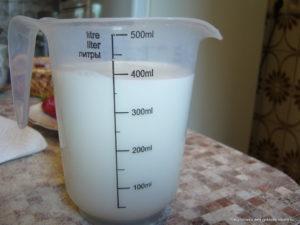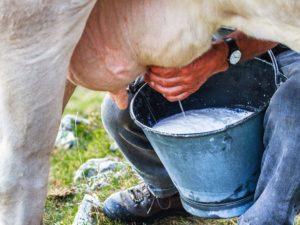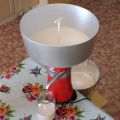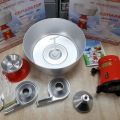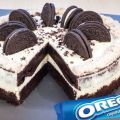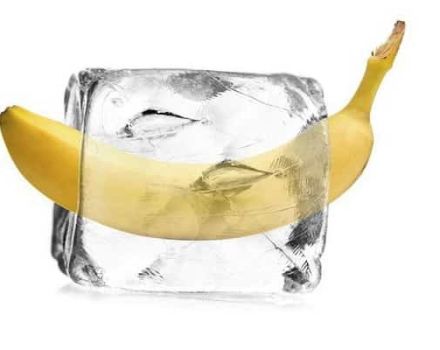Types of milk separators and the principle of operation, how to use the devices
For a successful farmer, the separator is one of the main devices. The simple unit instantly separates milk into nutritious cream and empty return. Sour cream, butter, cheese and other dairy products are made using separation. The operating principle of the milk processing separator has remained unchanged for over a hundred years, and once the process of separating cream was time-consuming and not so efficient.
What is a milk separator?
For centuries, people have been making cream by simply steeping milk. The process was long, and the result had to wait a whole day. Until 1878, gravity was the only way to separate cream from milk.
In the second half of the 19th century, the Swedish engineer Gustav de Laval presented a miracle to the world - a device called a "separator". With the help of centrifugal force, the device separated the milk into fat fractions and return.
Modern separators differ little from their predecessors - their operating principle has not changed. The device is necessary for obtaining any dairy product. With the help of the separator, the farmer makes butter, sour cream, cream, cheese. The separator not only separates milk into different fractions, but also cleans the product from accidental contamination.
Principle of operation and devices
The principle of operation of the device can be considered on the example of the operation of a household separator.
- Milk is poured into the drum of the device. The whole product rotates in a drum at 10,000 rpm.
- As a result of centrifugal force, heavy, fatty fractions (cream) are pressed against the walls of the device (thin layer).
- The skimmed part of the milk is concentrated in the center of rotation (thick layer).
- After stopping the drum, the cream and the fat-free part are drained from the separator through separate channels.
The splitting of milk into individual components is possible due to the special structure of the substance. The product consists of microscopic particles floating in a liquid medium. The density of fat and skim particles is very different. Greasy particles are easier to separate from the milk and, if left on for several hours, the cream will end up in the top of the container. The separator can significantly speed up the process of product splitting.

There is a drum at the top of the machine. The container is driven by a gearbox. The drum consists of perforated cones stacked on top of each other - plates.The elements are equipped with small spikes. They prevent the plates from sticking together. A space is created between the spiked plates in which the milk is split.
The set of plates is pushed onto a beaker installed at the base. The upper distribution cone is equipped with special outlets for draining skim milk and fatty milk. The branches are connected to branch arms. Through them, the ready-made fractions fall into the placed dishes. The regulator of the fat content of the fraction is also installed there.
In addition, the upper part of the drum is equipped with a cavity for the accumulation of foreign matter.
The unit is closed with a lid, the upper part of which is equipped with a float chamber. The device is designed for precise dosing of milk when feeding the product into the drum. A milk bowl is placed on the top of the separator. Through a special hole, the product enters the float chamber, and then into the drum container. The lower part of the unit consists of an electric motor or a manual drive. Most often, the device is powered by electricity.

Separator types
Modern units are divided into several types. Each of them performs a specific function and differs from other devices in design features and characteristics.
Devices are divided into 2 types:
- Powerful industrial machines for processing large quantities of milk. Complex installations are used in the food industry.
- Separators for domestic use. The unit is widely used in small farms.
Depending on the purpose, separators are divided into different types:
- Normalizers. They are used to prepare milk of a certain fat content.
- Cream separators. They are used to split milk into heavy cream and reverse.
- Cleaning units. Devices clean the product from impurities and contaminants. The operation is performed without separating milk into separate fractions.
- Universal separators. At the same time, the cream is separated and the milk is cleaned from impurities.
- Apparatus for separating curd mass (curd) into whey and curd.
- Devices for clarifying separated whey.
- Installations-clarifiers. Used for milk homogenization and clarification procedures.
- Apparatus for additional defatting of separated whey.
Most of the listed devices are used in food enterprises. For a small farm, it is enough to purchase the simplest, universal unit.
By design features, the devices are divided into 3 types:
- Open-type household separators. In this case, the product is in contact with air masses, both at the inlet and outlet. It should be noted that the milk produces a strong foam due to exposure to air. This is bad for the quality of the unit.
- Semi-closed devices. Here milk comes into contact with air masses only when it is fed into the drum. But the final products enter the containers through closed excretory paths.
- Closed installations. Sophisticated devices ensure milk processing without air access. Unfortunately, such devices are only a part of industrial equipment.
Household appliances are divided into manual or electric installations.
Selection rules
When buying a separator, you need to decide on the scope of future work. A household appliance can easily handle small quantities of milk. To do this, it is enough to purchase a device with a capacity of 50 l / h. The recommended capacity of the receiving bowl is 5-10 liters. To process farm products, you will need a powerful separator - 500 l / h.
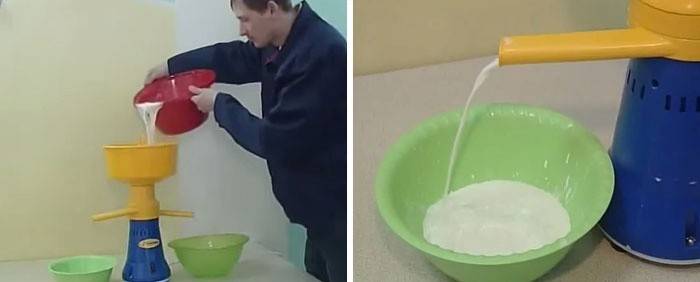
The estimated frequency of use of the device is important.It is recommended to purchase equipment with metal components under heavy load.
In other cases, you can opt for a plastic separator. Machines are available for sale with mechanical or electrical control.
Electrical units are more convenient and much more powerful than mechanical devices, however, in the absence of power supply, the equipment will be useless. Experienced farmers recommend both types of separators.
How to assemble a milk separator?
Work begins with the assembly of the drum. The prepared container is installed on a special spindle. Then the containers are installed to receive heavy cream and skim milk. The drum is closed with a lid, and a milk bowl is placed on top. Raw materials are poured into the prepared bowl and the device is turned on. The fat content regulator is used to correct the separator operation. If the procedure goes well, the device works quietly, without vibration or knocking.
Instructions for use
It is not difficult to use a household separator, however, for successful operation it is necessary to follow some rules:
- For the separation procedure, the milk must be prepared. Raw materials are heated to a temperature of 38-40 degrees. The thin film formed on the milk surface is removed.
- The device is turned on and allowed to run in idle mode for 3 minutes. Then 1 liter of water is poured into the drum and passed through the separator. After preparation, the unit can be used to process milk.
- Prepared milk is poured into the receiver bowl. During the operation of the device, it is necessary to monitor the flows of the separated fractions. First of all, heavy cream will appear, and then it will be the turn of the skim milk.
- The drum must be adjusted to obtain cream of the highest fat content. To do this, tighten the adjusting screw to the end, and then turn it in the opposite direction by 1.5 turns. If you want to get medium-fat cream, tighten the screw again to the end, and then turn in the opposite direction 3.5 turns.
- Before the beginning and end of the procedure, the separator is thoroughly washed with hot water. Soda is used as a cleaning agent. The unit is washed with a soft sponge or cloth. Do not use metal scouring pads and aggressive cleaning powders.
Possible malfunctions
The use of milk with a high acidity level leads to problems in the separator operation. In this case, the fat particles end up in skim milk. As a result, the protein fragments overflow the dirt collection container. The device has to be stopped frequently to clean the plates.
The efficiency of the separation procedure is reduced if the drum is installed incorrectly. If the container sits too low on the spindle, most of the cream flows back.



